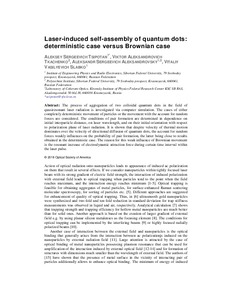Laser-induced self-assembly of quantum dots: deterministic case versus Brownian case
Скачать файл:
URI (для ссылок/цитирований):
https://doi.org/10.1016/j.photonics.2020.100791https://elib.sfu-kras.ru/handle/2311/142791
Автор:
Ципотан, А. С.
Ткаченко, В. А.
Александровский, А. С.
Слабко, В. В.
Коллективный автор:
Институт инженерной физики и радиоэлектроники
Базовая кафедра фотоники и лазерных технологий
Дата:
2020-07Журнал:
Photonics and Nanostructures - Fundamentals and ApplicationsКвартиль журнала в Scopus:
Q2Квартиль журнала в Web of Science:
Q2Библиографическое описание:
Ципотан, А. С. Laser-induced self-assembly of quantum dots: deterministic case versus Brownian case [Текст] / А. С. Ципотан, В. А. Ткаченко, А. С. Александровский, В. В. Слабко // Photonics and Nanostructures - Fundamentals and Applications. — 2020.Аннотация:
Abstract
The process of aggregation of two colloidal quantum dots in the field of quasiresonant laser radiation is investigated via computer simulation. The cases of either completely deterministic movement of particles or the movement with the account for random forces are considered. The conditions of pair formation are determined in dependence on initial interparticle distance, on laser wavelength, and on their initial orientation with respect to polarization plane of laser radiation. It is shown that despite velocity of thermal motion dominates over the velocity of directional diffusion of quantum dots, the account for random forces weakly influences on the probability of pair formation, the latter being close to results obtained in the deterministic case. The reason for this weak influence of Brownian movement is the resonant increase of electrodynamics attraction force during certain time interval within the laser pulse.

